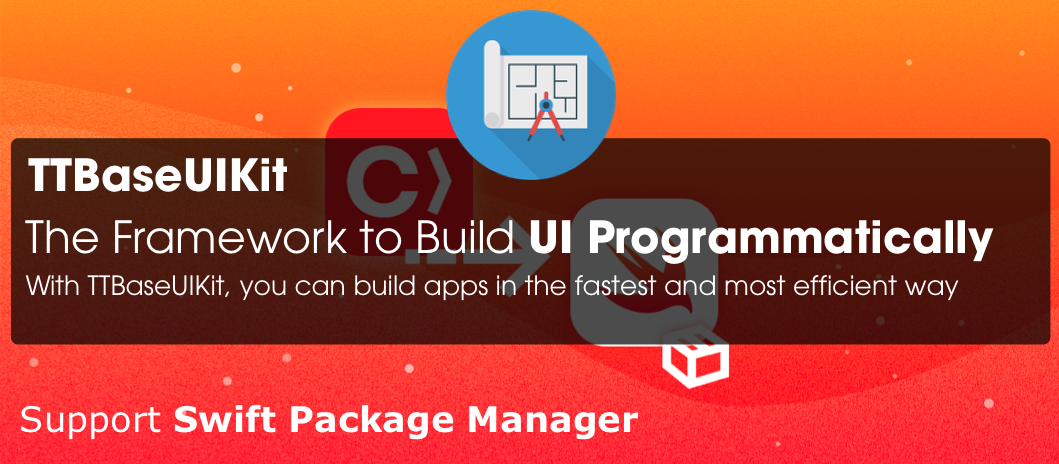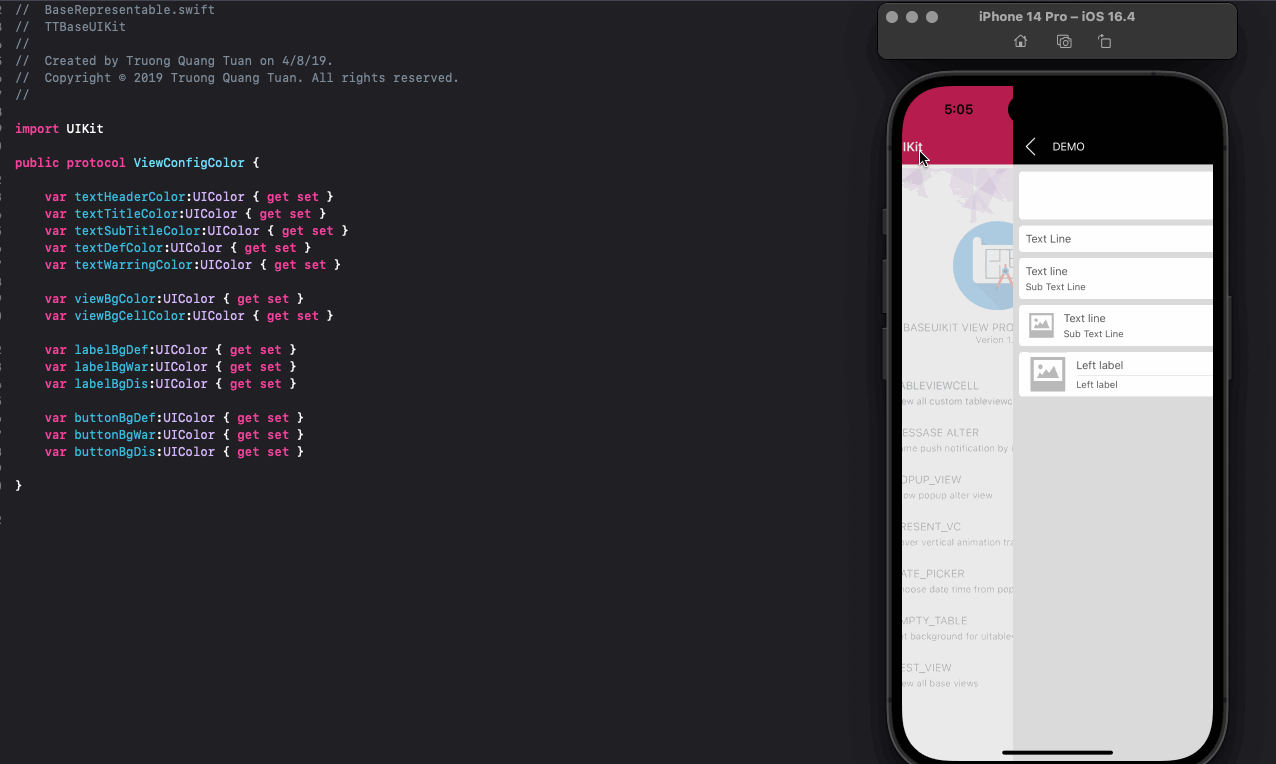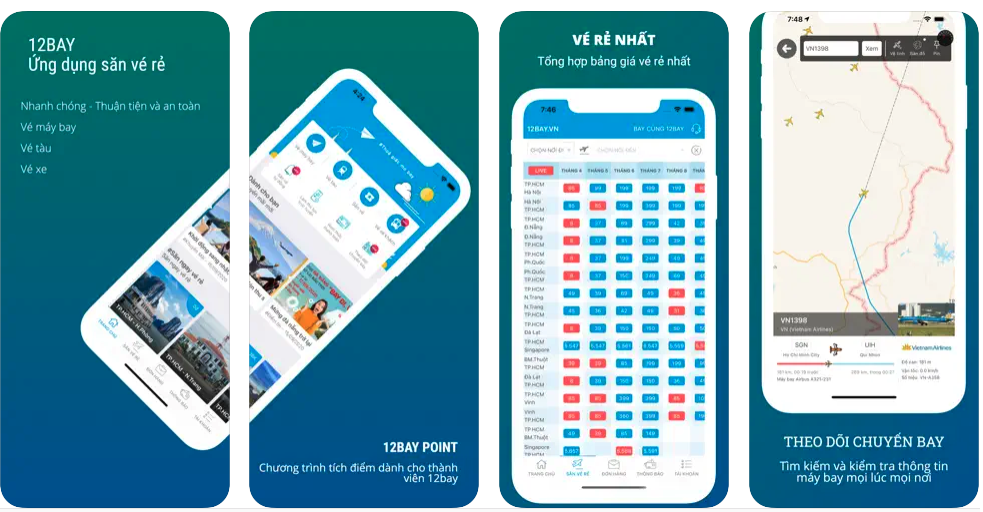Build your project with programmatically UI. You can see more details in here: TTBaseUIKit - Framework to Build UI Programmatically
Add the following line to your Podfile:



- File > Swift Packages > Add Package Dependency
- Add https://github.com/tqtuan1201/TTBaseUIKit.git
- Select "Up to Next Major" with "1.5.0"
Once you have your Swift package set up, adding Alamofire as a dependency is as easy as adding it to the dependencies value of your Package.swift.
dependencies: [
.package(url: "https://github.com/tqtuan1201/TTBaseUIKit.git", .upToNextMajor(from: "1.5.0"))
]
or
dependencies: [
.package(url: "https://github.com/tqtuan1201/TTBaseUIKit.git", branch: "master"),
]
If you encounter any problem or have a question on adding the package to an Xcode project, I suggest reading the Adding Package Dependencies to Your App guide article from Apple.
CocoaPods is a dependency manager for Cocoa projects. Add the following line to your Podfile:
pod 'TTBaseUIKit'Add the following line to your Cartfile:
github "tqtuan1201/TTBaseUIKit"- Put TTBaseUIKit repo somewhere in your project directory.
- In Xcode, add
TTBaseUIKit.xcodeprojto your project. - On your app's target, add the TTBaseUIKit framework:
- as an embedded binary on the General tab.
- as a target dependency on the Build Phases tab.
When you use this framework. You have the ability to control Color, FontSize, UI size. It helps you a lot when you apply themes, build apps on different platforms and they are easy to change. Config setting in AppDelegate
let view:ViewConfig = ViewConfig()
view.viewBgNavColor = UIColor.blue
view.viewBgColor = UIColor.white
view.buttonBgDef = UIColor.blue
view.buttonBgWar = UIColor.red
let size:SizeConfig = SizeConfig()
size.H_SEG = 50.0
size.H_BUTTON = 44.0
let font:FontConfig = FontConfig()
font.HEADER_H = 16
font.TITLE_H = 14
font.SUB_TITLE_H = 12
font.SUB_SUB_TITLE_H = 10
TTBaseUIKitConfig.withDefaultConfig(withFontConfig: font, frameSize: size, view: view)?.start(withViewLog: true)
self.window = UIWindow(frame: UIScreen.main.bounds)
self.window!.rootViewController = UINavigationController.init(rootViewController: YourViewController())
self.window!.makeKeyAndVisible()- With
ViewConfig, you can customize the most of colors forButton,Label,Background colors, ect. You can see all the config here: ViewConfig - With
SizeConfig, you can customize the most of size forButton,Label,Navigation,Conner radius,Icon,Textfield, ect. You can see all the config here: SizeConfig - With
FontConfig, you can customize the most of font size forTitle,SubTitle,Header, ect. You can see all the config here: FontConfig
Apply config by:
TTBaseUIKitConfig.withDefaultConfig(withFontConfig: font, frameSize: size, view: view)?.start(withViewLog: true)
TTBaseUIKit dramatically simplifies writing to build UI programmatically. Let's take a quick look at some examples, using TTBaseUIKit from Swift.
let noti:TTBaseNotificationViewConfig = TTBaseNotificationViewConfig(with: window)
noti.setText(with: "WELCOME ^^", subTitle: "Just demo little element ui with write by programmatically swift")
noti.type = .NOTIFICATION_VIEW
noti.touchType = .SWIPE
noti.notifiType = .SUCCESS
noti.onShow()let popupVC = TTPopupViewController(title: "SOMETHING LIKE THIS", subTitle: "Lorem Ipsum is simply dummy text of the printing and typesetting industry. Lorem Ipsum has b", isAllowTouchPanel: true)
yourVC.present(popupVC, animated: true)yourVC.tableView.setStaticBgNoData(title: "NO DATA", des: "Contrary to popular belief, Lorem Ipsum is not simply random text. It has roots in a piece of classical Latin literature from 45 BC, making ") {
print("Touch handle!!!!")
}This is a protocol use to easily organize UI handling code. You can see all configs here: ViewCodable
-
func setupViewCodable(with views : [UIView])
This function calls all other functions in the correct order. You can use it in an UIViewController viewDidLoad method or in a view initializer, for example.
-
func setupStyles()
This function should be used to apply styles to your customs views.
-
func setupData()
This function should be used to set data
-
func setupConstraints()
This function should be used to add constraints to your customs views
-
func setupBaseDelegate()
This function should be used to set delegate for views
import TTBaseUIKit
class YourCustomView : TTBaseUIView {
override func updateBaseUIView() {
super.updateBaseUIView()
}
}
extension YourCustomView :TTViewCodable {
func setupStyles() {
}
func setupCustomView() {
}
func setupConstraints() {
}
}import TTBaseUIKit
class BaseUIViewController: TTBaseUIViewController<DarkBaseUIView> {
var lgNavType:BaseUINavigationView.TYPE { get { return .DEFAULT}}
var backType:BaseUINavigationView.NAV_BACK = .BACK_POP
override func viewWillAppear(_ animated: Bool) {
super.viewWillAppear(true)
self.updateForNav()
}
public override init() {
super.init()
self.navBar = BaseUINavigationView(withType: self.lgNavType)
self.setDelegate()
}
public convenience init(backType:BaseUINavigationView.NAV_BACK) {
self.init()
self.backType = backType
}
public convenience init(withTitleNav title:String, backType:BaseUINavigationView.NAV_BACK = .BACK_POP) {
self.init()
self.backType = backType
self.setTitleNav(title)
}
public convenience init(withNav nav:BaseUINavigationView, backType:BaseUINavigationView.NAV_BACK = .BACK_POP) {
self.init()
self.backType = backType
self.navBar = nav
self.setDelegate()
}
required init?(coder aDecoder: NSCoder) {
fatalError("init(coder:) has not been implemented")
}
}
// MARK: For private base funcs
extension BaseUIViewController {
fileprivate func setDelegate() {
if let lgNav = self.navBar as? BaseUINavigationView { lgNav.delegate = self }
}
fileprivate func updateForNav() {
if let lgNav = self.navBar as? BaseUINavigationView {
lgNav.setTitle(title: "TTBASEUIVIEW_KIT")
}
}
}
// MARK: For public base funcs
//--NAV
extension BaseUIViewController {
func setTitleNav(_ text:String) {
self.navBar.setTitle(title: text)
}
func setShowNav() {
self.statusBar.isHidden = false
self.navBar.isHidden = false
}
func setHiddenNav() {
self.statusBar.isHidden = true
self.navBar.isHidden = true
}
}
extension BaseUIViewController :BaseUINavigationViewDelegate {
func navDidTouchUpBackButton(withNavView nav: BaseUINavigationView) {
if self.backType == .BACK_POP {
self.navigationController?.popViewController(animated: true)
} else if self.backType == .BACK_TO_ROOT {
self.navigationController?.popToRootViewController(animated: true)
} else {
self.dismiss(animated: true, completion: nil)
}
}
func navDidTouchUpRightButton(withNavView nav: BaseUINavigationView) {
}
}import TTBaseUIKit
class BaseUITableViewController: TTBaseUITableViewController {
override var navType: TTBaseUIViewController<TTBaseUIView>.NAV_STYLE { get { return .STATUS_NAV}}
var lgNavType:BaseUINavigationView.TYPE { get { return .DEFAULT}}
var backType:BaseUINavigationView.NAV_BACK = .BACK_POP
override func viewWillTransition(to size: CGSize, with coordinator: UIViewControllerTransitionCoordinator) {
super.viewWillTransition(to: size, with: coordinator)
DispatchQueue.main.async { [weak self] in guard let strongSelf = self else { return }
guard let headerView = strongSelf.tableView.tableHeaderView else { return }
headerView.layoutIfNeeded()
let header = strongSelf.tableView.tableHeaderView
strongSelf.tableView.tableHeaderView = header
}
}
override func updateBaseUI() {
super.updateBaseUI()
self.navBar = BaseUINavigationView(withType: self.lgNavType)
self.setDelegate()
}
}
//For Base private funcs
extension BaseUITableViewController : BaseUINavigationViewDelegate{
fileprivate func setDelegate() {
if let lgNav = self.navBar as? BaseUINavigationView { lgNav.delegate = self }
}
func navDidTouchUpBackButton(withNavView nav: BaseUINavigationView) {
self.navigationController?.popViewController(animated: true)
}
}TTBaseUIKit to make easy Auto Layout. This framework provides some functions to setup and update constraints.
setLeadingAnchor: Set/Update value for current view or super viewsetTrailingAnchor(_ view:UIView? = nil, isUpdate:Bool = false, constant:CGFloat, isApplySafeArea:Bool = false, priority:UILayoutPriority? = nil)setTopAnchor(_ view:UIView? = nil, isUpdate:Bool = false, constant:CGFloat, priority:UILayoutPriority? = nil)setBottomAnchor(_ view:UIView? = nil, isUpdate:Bool = false, constant:CGFloat,isMarginsGuide:Bool = false, priority:UILayoutPriority? = nil)setCenterXAnchor(_ view:UIView? = nil, isUpdate:Bool = false, constant:CGFloat)setcenterYAnchor(_ view:UIView? = nil, isUpdate:Bool = false, constant:CGFloat)
TTBaseUIKit provides common handling functions for String, Date, Json, Device, Language, VietNamLunar , Validation, NetworkSpeedTest
For more examples and usage, please refer to example project TTBaseUIKitExample
During my work, I have updated and used this framework in many projects. All my project using UI programmatically instead of using Storyboard. Here are some screenshoots of the apps:
You can see all my projects here: Link
- Reusable codes
- Speed up your project
- Easy to use
- Must build app to see UI,
SwiftUIsolved that problem I was thinking about.
For more examples and usage, please refer to example project [TTBaseUIKitExample]
Truong Quang Tuan – @website/gmail – truongquangtuanit@gmail.com
Distributed under the XYZ license. See LICENSE for more information.
https://github.com/tqtuan1201/TTBaseUIKit
We build high quality apps! Get in touch if you need help with a project.
TTBaseUIKit is distributed under the MIT license. See LICENSE for details.






